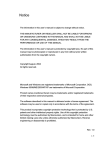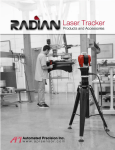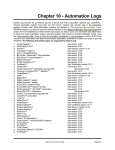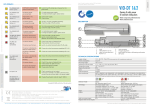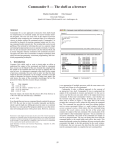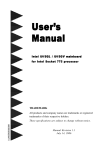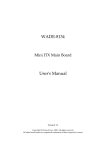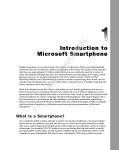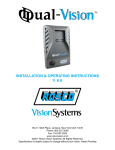Download Maxwell User`s Manual
Transcript
User's manual HCL INFOSYSTEMS LIMITED www.hclinfosystems.in HEAD OFFICE HCL INFOSYSTEMS LIMITED Sector XI,@E4,5,6, Nodia-201 301. Notebook PC User's Guide Preface Symbols and Conventions The information in this document is subject to change without prior notice in order to improve reliability, design and function and does not represent a commitment on the part of the manufacturer. In no event will the manufacturer be liable for direct, indirect, special, incidental, or consequential damages arising out of the use or inability to use the product or documentation, even if advised of the possibility of such damages. This document contains proprietary information protected by copyright. All rights are reserved. No part of this manual may be reproduced by any mechanical, electronic, or other means in any form without prior written permission of the manufacturer. Trademarks All product names mentioned herein are used for identification purposes only and may be trademarks and/or registered trademarks of their respective companies. Limitation of Liability While reasonable efforts have been made to ensure the accuracy of this manual, the manufacturer and distributor assume no liability resulting from errors or omissions in this manual, or from the use of the information contained herein. Using This Manual This User’s Manual contains general information about the hardware and software setup, troubleshooting, and technical specifications of the notebook computer. NB - MAXWELL The following conventions and symbols are used in this manual: When keys are to be pressed at the same time, a plus (+) symbol is used. For instance, Fn+F7 means holding Fn and F7 keys at the same time. When a series of clicking actions is needed in Windows O/S, [ ] and > symbols are used. For instance, [Start > Settings > Control Panel > Display] means clicking the Start icon first, then the Settings, then the Control Panel, then the Display icon. When you need to make a selection with the touch pad (or mouse), you will be asked to ’select’ or ‘click’ or ‘double-click’, ‘right-click’ the item. Note Text in this format and symbol means specific instructions, commentary, sidelights, or any additional information or notes that you should be aware of. Warning Text in this format and symbol means that failures to comply with the given instructions or information could result in damage to your computer or could cause bodily harm or loss of life. CONTENTS Chapter 1 Before You Start 1 Chapter 2 Getting To Know The Basics 5 Chapter 3 Battery Power & Power Management 24 Chapter 4 Trouble Shooting 31 Notices Federal Communications Commission Radio Frequency Interference Statement Note... This equipment generates, uses, and can radiate radio frequency energy and if not installed and used in accordance with the instruction manual may cause harmful interference to radio communications. However, there is no guarantee that interference will not occur in a particular installation. If this equipment does cause harmful interference to radio or television reception, which can be determined by turning the equipment off and on, the user is encouraged to try to correct the interference by one or more of the following measures: Reorient or relocate the receiving antenna. Increase the separation between the equipment and receiver. Connect the equipment into an outlet on a circuit different from that to which the receiver is connected. Consult the dealer or an experienced radio TV technician for help. Notice: Changes or modifications not expressly approved by the party responsible for compliance could void the user’s authority to operate the equipment. Shielded interface cables and a nonshielded AC power cord must be used in order to comply with emission limits. This equipment is to be used with power supply: 65W There is no internal power supply. Chapter - 1 Before You Start Protecting Your Computer Avoid Abusive Handling and Adverse Environment Follow the advice below will help ensure that you get the most out of your Investment. When cleaning the computer, observe these steps: Your computer will serve you well if you take good care of it. Do not expose the computer to direct sunlight or place it near sources of heat. o o o Do not subject it to temperatures below 0 C (32 F) or above 30 C (86oF). Do not expose the computer to magnetic fields. Do not expose the computer to moisture or rain. Do not spill water or liquid on the computer. Do not subject the computer to adverse shock and vibration. Do not expose the computer to dust and dirt. Do not place objects on top of the computer to avoid damaging the computer. Do not place the computer on rocky surfaces. Here are some ways of taking care of your AC adapter. Do not connect the adapter to any devices other than your computer. Do not let water get into the adapter. Do not block the ventilation airway of the adapter. Keep the adapter in a cool and ventilated place. Do not step on the power cord or place heavy objects on top of it. 1 Carefully tuck away the power cord and any cables away from pedestrian traffic. When unplugging the power cord, do not pull on the cord itself but pull on the plug. Keep the adapter away from children. The total ampere ratings of the equipment plugged in should not exceed the ampere rating of the cord if you are using an extension cord. The total current rating of all equipment plugged into a single wall outlet should not exceed the fuse rating. Do not connect other AC adapter to your notebook. Connect the one which it is supplied with. Power off the computer and remove the battery pack. Disconnect the AC adapter. Use a soft cloth dampened with water. Do not use liquid or aerosol cleaners. Contact your dealer or see your service technician if any of the following occurs: Computer has been dropped or the body has been damaged. Liquid has been spilled into the product. The computer does not operate normally. Cleaning the Ventilation Grills: It is suggested that you clean the ventilation grills regularly to maintain optimal thermal regulation of the notebook. To do this, you may use a soft brush or a vacuum cleaner (with appropriate head adapter) to remove the dust buildup on the ventilation grills. 2 Things You Must Remember Before Working On Your Computer Let Your Computer Acclimate Itself Your notebook can easily stand temperature extremes but it doesn’t like rapid changes in temperature, like going from the cold outdoors to a warm office. Rapid changes in temperature can cause water droplets to condense inside your case, threatening to damage the electronic parts inside. After receiving your notebook when it’s hot or cold outside, try not to power up the computer immediately, let the computer adjust to the room temperature gradually at least for three to four hours. Suitable Place To Work Your computer will run well wherever you’re comfortable but extremes of temperature and humidity can be challenging to your system’s parts. There are some things you can tolerate that the computer can’t – things like static electricity, dust, water, steam and oil. In case you decide to pull over for roadside computing, try to choose a clean, comfortable work area for your system. If you are running your system for the first time on battery power, remove the battery from the package, install it into the system and recharge the battery to fully prepare for service. Warning If your system arrives in cold weather, do not apply power to the computer or monitor until they have been allowed to come to room temperature. Heat, Cold, Humidity, And Glare Find a suitable place for your computer that’s not too hot, too cold, too dark, or too bright. Glare can make it hard to read the screen. Try to avoid the computer components from being destroyed if it is over heated, so try to allow plenty of room for air to circulate around the case. Do not block the ventilation opening. Do not place your computer in direct sunlight. 3 4 Chapter - 2 Getting To Know The Basics Expandability The system offers upgradeable hard disk drive and 2 DDR II SDRAM sockets for expansion, allowing the user to easily increase the storage and system capacities as the need arises. Built-in Multiple Card Reader There is built-in 4-in-1 card reader to access many of the portable media formats (SD Card, MS Card, MMC Card, and MS-Pro Card). Performance Features Ethernet Port High Performance Processor with Alviso Chipset The notebook PC is equipped with a powerful Mobile Intel Pentium M or Celeron M processor. Together with the latest Alviso chipset and technologies, the system offers very advanced PC performances. Advanced Graphic Engine The Intel Integrated GMA900 Extreme3 video processor gives excellent graphic performance. The advanced graphic chip also incorporates a hardware-based motion-compensation engine, which gives you smooth MPEG video playback. 3D graphics capability also adds realism to PC games. The system provides built-in Ethernet network adapter for high bandwidth network connection. Firewire (IEEE1394 / 1394a) and USB2.0 ports In addition to a full array of built-in I/O ports, the computer offers IEEE1394 for ultra high-speed connection to high bandwidth digital video devices and USB2.0 ports to connect to any USB-based peripheral devices. Wireless LAN (optional) The internal Wireless LAN module allows your notebook to connect wirelessly to other 802.11-enabled systems, devices, or network. LCD Display The computer is equipped with a wide 14-inch TFT high-resolution display panel for clear text and brilliant colors. Serial ATA Hard Disk Drive Support The serial ATA bus offers higher data throughput than the traditional parallel ATA bus. The hard disk drive also supports 5400 RPM. The system achieves excellent hard drive performance. ExpressCard (New Card) Technology ExpressCard (New Card) is the next-generation of the PC Card standard. The bus interface is based on the two standards: PCI Express for high-performance I/O and USB2.0 for variety of devices. The card slot is compatible with both 34-mm and 54-mm type cards. 5 6 3. Touch Pad System At A Glance The touch pad is a built-in pointing device with functions similar to a mouse. Top View 4. Built-in Microphone The built-in microphone records sound. 5. Power / Suspend Button The power/suspend button turns the notebook on and off and it also acts as a system suspend key. Press momentarily to turn on the system. Press and hold for at least 4 seconds to turn off the system. How this key behaves can be defined in [Start > Settings > Control Panel > Power Options > Advanced] menu. Press the power / suspend button again to return from the suspend mode. 6. Silent Mode Button Pressing the key enables the system to lower its power usage; therefore the fan speed is reduced to achieve lowest operating noise. 7. Internet Explorer Quick Key Pressing the button launches Internet Explorer in Windows. 8. LED Status Indicator The LED Status indicators reveal the status of these functions: Numeric keypad, cap lock, scroll lock, WLAN module enabling and disabling and also the ODD, HDD activities. (See the LED Status Indicator Section for details.) The LED Status indicators also reveal the status of the system power state and battery-charging state. See the LED Status Indicator Section for details. 1. LCD Display The panel is where the system content is displayed. 2. Keyboard The keyboard is used to enter data. It has an embedded numeric keypad and cursor control keys. (See Keyboard Section for details.) 7 8 5. Battery Pack Front and Rear Views The battery pack is a built-in power source for the notebook. 6. External VGA Port The VGA video output port is for connecting the external LCD monitor or projector. 7. Ethernet / LAN Port The port connects to a network hub via the RJ-45 cable and also conforms to 10/100Base-TX transmission protocol. 8. Power Jack (DC-in) The DC-out jack of the AC Adapter connects here and powers the computer. Warning Do not place any heavy objects on the top of notebook. This may damage the display 1. Microphone/Audio Line-in Jack The microphone/Audio Line-in jack (3.5-mm diameter) is where you connect a microphone or an external audio input source such as a CD Player.. 2. Stereo Headphone / SPDIF-out Jack The stereo headphone jack (3.5-mm diameter) is where you connect the headphones or external speakers. Alternatively, you may connect the SPDIF output to an external DTS, AC3, or PCM sound processor / decoder in your home stereo system. 3. Wireless On/Off Switch Use the Switch to disable or enable the Wireless function. 4. Kensington Lock Key Hole A Kensington-type security lock latches to this keyhole for anti-theft purpose. 9 10 4. Modem Port Side Views This is where you plug the phone jack (RJ-11) for fax/modem functions. 5. Ventilation Grill The fan grill is where air is exchanged to dissipate the internal heat. Do not block this airway completely. 6. TV (S-Video) Port The S-Video port permits you to redirect the screen output to a television set or any analog video playback device. This TV Port is copyright protected; when DVD movie is played, the output is scrambled to prevent analog recording. 7. Firewire / IEEE1394 / 1394a Port Warning Do not place any heavy objects on the top of notebook. This may damage the display This is a high-speed serial data port. You may connect any Fire-wireready device to this port. 8. ExpressCard (New Card) Slot 1. USB2.0 Port (x3) The Universal Serial Bus (USB2.0-compliant) port allows you to connect a wide variety of devices to your computer at a rate of up to 480 Mbps. This port conforms to the latest USB2.0 plug-and-play standards. The slot is where Express Card (Type 54) is inserted. ExpressCard Type 54 allows insertion of 54mm and 34mm cards. ExpressCard integrates both the PCI-Express bus technology and USB2.0 standards. 2. 4-in-1 Card Reader The 4-in-1 Card Reader supports SD Card, MMC Card, and MS Card. 3. Optical Drive and Disk Eject Button and Manual Eject Key Hole If your computer comes with the Combo drive, DVD-RW, DVD+RW, or DVD-Dual drive, you may save data onto a CD-R / CD-RW or DVD RW disc. Press the eject button to eject the disk tray. The manual eject keyhole allows you to manually eject a jammed disk. 11 12 2. Built-in Stereo Speakers Bottom View The built-in speakers output the sound in stereo. 3. System Device Cover The system’s processor with cooler assembly, Wireless LAN module, HDD and DDR memory module are located under the case cover. The system memory and hard disk drive can be upgraded to a larger capacity. 4. Ventilation Grill The fan grill is where air is exchanged to dissipate the internal heat. Do not block this airway completely. 4 Warning Do not block the Fan Grill outlet. Place the machine on hard surface only. The bottom case may get very hot. 1. Battery Pack and Battery Latch The battery pack is a built-in power source for the notebook. Slide the battery latch to release the battery pack. 13 14 AC Adapter LED Status Indicator The LED Status Indicator displays the operating status of your notebook. When a certain function is enabled, an LED will light up. The following section describes its indication. System & Power Status Indicators LED Graphic Symbol Indication Green light indicates the system is ON. Green light indicates the WLAN module is active. 1. DC-out Connector The DC-out connector docks to the power jack (DC-in) on the computer. 2. Adapter The adapter converts alternating current into constant DC voltage for the computer. 3. AC Plug Blinking green light indicates the notebook is in suspend mode. Green light blink 5 times and then it glows persistently under normal windows operation which indicates the silent mode. Blinking orange light indicates the battery is being charged. The AC plug plugs to the AC wall outlet. Blinking red light indicates the battery power is low when the system is turned ON. Warning Persistent green light indicates the battery is Full. Make sure you are using a standard 3-prong AC wall socket with a ground pin. If not, you may feel a slight tingling sensation on any of the computer’s metal parts such as the I/O ports. This is caused by leakage current when the AC adapter is not properly grounded (via the ground pin). However, the amount of leakage current is within the safety regulation and is not harmful to human body. Green light indicates the hard drive and/or optical drive is being accessed. Green light indicates the numeric keypad is activated. Green light indicates the cap-lock is activated. Green light indicates the scroll-lock is activated. 15 16 Keyboard Features Windows Keys Your keyboard also has two Windows keys: Function Keys (Quick Keys) Graphic Symbol Action System Contror Start Key Fn+F1 Enters Suspend Mode. This key allows you to pull up the Windows Start Menu at Fn + F3 Turns of the battery warning beep off or on. the bottom of the taskbar. Fn + F4 Changes Display Mode: LCD-only, CRT-only and LCD&CRT. Fn + F5 Turns Speaker Volume up. Fn + F6 Turns Speaker Volume down. Fn + F7 Increases Display Brightness. Fn + F8 Decreases Display Brightness. Fn+Num Lk Enables the embedded keypad to work in numeric mode. The keys act like numeric keypads in a calculator. Use this mode when you need to do a lot of numeric data entry. An alternative would be to connect an external numeric keypad. Fn + Scr Lk Application Menu Key This key brings up the popup menu for the application, similar to a click of the right mouse button. Embedded Numeric Keypad Press Fn+NumLk to enable the embedded numeric keypad. The numbers are printed in upper right corner of a key, in a color different from the alphabets. This key pad is completewith arithmetic operators (+, -, * , /). Press Fn+NumLk to revert to normal character keys. Scrl Lk Press the Scroll Lock key and then press á or â to move one line up or down. For various system controls, press the Fn (Function) key and the Fx key simultaneously. 17 18 Tips on Using the Touch Pad: Touch Pad The built-in touch pad, which is a PS/2-compatible pointing device, senses movement on its surface. As you move your fingertip on the surface of the pad, the cursor responds accordingly. The double-click speed is timed. If you double-click too slowly, your notebook responds as if you single-clicked twice. Keep your fingers dry and clean when using the touch pad. Also keep the surface of touch pad clean and dry to prolong its life. The touch pad is sensitive to finger movements. Hence, the lighter the touch, the better the response. Heavy touch does not produce better response. The following items teach you how to use the touch pad: Move your finger across the touch pad to move the cursor. Press buttons to select or execute functions. These two buttons are similar to the left and right buttons on a mouse. Tapping on the touch pad twice produces is similar to clicking the left button of a mouse. Function Left Button Execution Click twice quickly Tap twice (at the same speed as double-clicking the mouse button) Selection Click once Tap once Drag Click and hold to drag the cursor Tap twice quickly and on the second tap hold finger to the touch pad to drag the cursor Access Context Menu Right Button Click once Equivalent Tapping Action Tap twice quickly and on the second tap hold finger to the touch pad to drag the cursor Graphic Subsystem Your computer uses a high performance 14-inch active matrix TFT panel with high resolution and multi-million colors for comfortable viewing. The Intel integrated GMA900 Extreme3 video graphics accelerator, which is Microsoft DirectX 9 compatible, performs graphic rendering at a lighting-fast speed. Adjusting the Display Brightness The notebook uses special key combinations, called hot keys, to control brightness. Press Fn+F7 to increase the brightness. Press Fn+F8 to decrease the brightness. Note To maximize your battery operating time, set the brightness to the lowest comfortable setting, so that the internal backlight uses less power. Move One Page Up or Down 19 20 Extending the Life of the TFT Display Device Audio Subsystem Observe the following guidelines to maximize the life of the backlight in the display. Set the brightness to the lowest comfortable setting (Fn+F8). When working at your desk, connect your notebook to an external monitor and disable the internal display Fn+ F4. Do not disable the suspend time-outs. If you are using AC power and have no external monitor attached, change to suspend mode when not in use. Opening and Closing the Display Panel To open the display, simply lift up the lid. Then tilt it to a comfortable viewing position. To close the display cover, fold it down gently. Your computer’s audio subsystem is Sound Blaster Pro-compatible. Adjusting the Volume Manually To increase the volume, press Fn+F5. To decrease the volume, press Fn+F6. Adjusting the Audio Volume in Windows Click the speaker symbol in the task tray in Windows. Drag the volume control bar up or down to adjust the volume. To temporarily silence the speaker without changing the volume setting, click Mute. Voice Recording Warning You will need to plug-in an external microphone to the To avoid damaging the display, do not slam it when closing. Do not place any object on top of the computer when the display is closed. microphone connector to record sound. Modem Your computer comes with a 56K V.92 internal fax/modem and a phone jack (RJ-11), which is located on the left side of your computer. Use a telephone cable to connect the computer to the telephone wall outlet. Connecting the Modem Plug one end of the phone line into the modem port located on the rear side of the computer. (For EMI compliance, you need to clip the included EMI CORE to the phone line.) Plug the other end of the line into the analog phone wall outlet. Depending on where your computer is used, you may need to change the country setting in the modem. Correct setting will allow you to maintain a stable connection in a country where its telecommunication system may be different to others. 21 22 Ethernet Chapter - 3 Battery Power & Power Management Your computer is equipped with a 10/100Base-TX Fast Ethernet network adapter. Connect the active LAN cable to the RJ-45 LAN port located on the left side of the computer. This allows you to access and transmit data in the local area network. Connecting to the Network Use Unshielded Twisted Pair (UTP) Ethernet cable only. Insert one end of the UTP cable into the network connector until the connector snaps securely into the receptacle. Either connect the other end of the cable to an RJ-45 jack wall outlet or to an RJ-45 port on a UTP concentrator or hub in the network. Cabling Restriction for Networks The following restrictions should be observed for 100BASE-TX networks: The maximum cable run length is 100 meters(m) (328 feet[ft]). For 100-Mbps operations, use Category 5 wiring and connections. Note In this chapter, you will learn how to operate your notebook on battery power, how to handle and maintain the battery pack, and learn about the system’s power saving features. TFT display, central processor, hard disk drive are the major hardware subsystems that consume the most power. Power management deals how these key components should behave to conserve power. For example, you can have the system turn off its display after 2 minutes of inactivity to save power. Efficient power management can help you work longer sessions before having to recharge the battery. The Battery Pack Lithium-Ion Battery Consult Windows manual and / or Novell Netware user’s guide for the software installation, configuration, operation of the network. Your notebook uses a six-cell or nine-cell Lithium-Ion battery pack that provides power when you don’t have access to an AC outlet. Note It is necessary that you charge the battery pack for at least 6 hours before using it for the first time. In the Standby Suspend mode, a fully charged battery loses its power in roughly 1/2 day or less. When not being used, the battery’s power will deplete in 1-2 month. 23 24 Battery Low-Power Warning Installing and Removing the Battery Pack Low Battery Warning To Remove the Battery Pack: Low battery condition occurs when battery power is reduced to 6%. The red battery status LED indicator blinks and the system beeps once every 16 seconds or so. Very Low Battery Warning Place the notebook bottom-side up on a flat and secured surface. Push the latch and pull the battery’s hard case away from the notebook. Very Low battery condition occurs at 3 % power remaining. The red battery status LED indicator blinks and the system beeps at 4-second interval. When the notebook warns you of its low battery condition, you will have about 3-5 minutes to save your current work. Warning Do not expose battery packs to temperatures below 0 degree Celsius (32 degree F) or above 60 degree C (140F). This may adversely affect the battery pack. Note Press Fn+F3 to turn off the battery warning beep. 25 26 To Install the Battery Pack: Place the notebook bottom-side up on a flat and secured surface. Carefully insert the battery pack into the battery compartment of the notebook. Checking the Battery Level You can check the remaining battery power in the Windows battery status indicator, which is located at the lower right-hand corner of the task bar. (If you do not see a battery or AC-in icon on the task tray, go to Power Options Properties box and click on the Advanced tab. Check off ``Always show icon on the task bar``.) Alternatively, you can access the power meter by clicking the Power Options icon in the Windows Control Panel. Prolonging the Battery’s Life and Usage Cycles There are ways you can do to prolong the use of battery. Use the AC adapter wherever AC wall outlet is available. This will ensure uninterrupted computing. Purchase additional battery pack. Store the battery pack in room temperature. Higher temperature tends to deplete the battery’s power faster. Make good use of the power management function. Save To Disk (Hibernate) saves the most energy by storing current system contents in a hard disk space reserved for this function. The life expectancy of the battery is approximately 300 recharges. See the notices section in the beginning of the user manual on how to care for the battery pack. Charging the Battery and Charging Time To charge the battery, while the battery pack is in the notebook, plug the AC adapter into the notebook and an electrical outlet. The charging time is approximately 4-6 hours when the notebook is turned off and approximately 6-10 hours when the notebook is turned on. When the battery is fully charged, the battery charge indicator becomes green. Note Note If system runs at heavy loading or in a high temperature environment, the battery may not be fully charged. You need to continue to charge it with the AC adapter plugged in until the charging LED turns green. 27 Read Section Protecting Your Notebook in the beginning of this manual for tips about how to maintain the battery pack. 28 Suspend Mode Note Standby Suspend To achieve optimal battery performance, you may need to do a battery calibration at a 3-month interval. To do this: Fully charge the battery. Then discharge the battery by entering the BIOS setup screen. (Press F2 key as soon as you turn on the computer. And let it remain at the setup screen until the battery runs out. Fully charge the battery again. Using Windows Power Options Windows Power Management provides basic power saving features. In the Windows Power Options Properties [Start > Settings > Control Panel > Power Options] dialogue box, you may enter time-out values for display and hard disk drive. Windows power manager saves power by turning off hard drive after 1 minute of inactivity, for example. The system automatically enters this mode after a period of inactivity, which is set in the Power Schemes dialog box. In Standby mode, hardware devices, such as display panel and hard disk, are turned off to conserve energy. Hibernate Suspend In this mode, all system data are saved in the hard disk before powering down. When this mode is activated, all system state and contents are saved to the hard disk drive after a period of inactivity defined by the user. No power or very little power is drawn from the battery module under this mode. However, depending on how much RAM that have been installed on your computer, the amount of time the system requires to restore all its previous contents can range from 5 to 20 seconds. For Windows 2000 / XP users, hibernation is handled by the operating system; therefore, no special disk partition or disk file is necessary. If you wish to activate Hibernate mode, you need enable Hibernate Support in the Hibernate tab of the Power Options menu. Windows’ Power Schemes The power management control panel in Windows XP, known as Power Schemes, is designed to provide the user with an easy-to-use interface. The Power Schemes tab can be found in the Power Options Properties panel that is accessible via the control panel window. Schemes are easy to understand, based on notebook usage scenarios, and control not only processor power usage but other system peripherals as well. Go to [Start > Settings > Control Panel] and double-click the Power Options icon. Always on mode puts the processor into maximum performance mode, which provides no power saving. The other schemes control processor performance based on demand. For example, Max Battery mode lowers the processor’s speed and voltage to conserve power as much as possible. 29 30 Chapter - 4 Trouble Shooting Your computer has been fully tested and complies with the system specifications before shipping. However, incorrect operations and/or mishandling may cause problems. This chapter provides a reference for identifying and correcting common hardware and software problems that you may encounter When you encounter a problem, you should first try to go through the recommendations in this chapter. Instead of returning the computer and waiting for repair, you may easily solve the problems by considering the following scenarios and possible solutions. If the error continues, contact your reseller for service information. Before taking further actions, consider the following suggestions: Be sure all the device drivers are installed properly. For example, without the audio driver properly installed, the speakers and microphone will not work. If external devices such as USB camera, scanner, printer do not function correctly when connected to the system, it is usually the device’s own problem. Consult the device’s manufacturer first. Some software programs, which have not gone through rigorous coding and testing, may cause problems during your routine use. Consult the software vendor for problem solving. Legacy peripheral are not plug-and-play capable. You need to restart the system with these devices powered up and connected first. Be sure the Quick Key Lockout Switch on the bottom of the computer is not engaged; otherwise the quick keys will not work. Audio Problems No speaker output Software volume control is turned down in Microsoft Sound System or is muted. Double-click the speaker icon on the lower right corner of the taskbar to see if the speaker has been muted or turned down all the way. Check to see if the problem persists when all the external devices are removed. Check to see that the green light indicator on the AC adapter is lit. Check to see the power cord is properly plugged to the wall outlet and to the computer. Most audio problems are software-related. If your computer worked before, chances are software may have been set incorrectly. Go to [Start > Settings > Control Panel] and double-click the Sounds and Audio Devices icon. In the Audio page, make sure that Realtek HD Audio is the default playback device. Check to see the power indicator of the computer is on. Check to see if your keyboard is operational by pressing and holding any key. Check for any incorrect or loose cable connections. Make sure the latches on the connectors latch securely on to the receptor end. 31 32 Sound cannot be recorded - The hard disk drive has reached its capacity - Double-click the speaker icon on the lower right corner of the taskbar to see if the microphone has been muted. Click Options and select Properties. Select Recording and click the OK button. After Click OK button, the recording volume control panel will appear. Go to [Start > Settings > Control Panel] and double-click the Multimedia icon (or Sounds and Audio Devices icon). In the Volume or Audio page, make sure that Realtek HD Audio is the default recording device. Hard Disk Problems The hard disk drive does not work or is not recognizable If you had just performed a hard disk upgrade, make sure the hard drive connector is not loose and the hard disk drive is also correctly seated. Remove it and reinsert it firmly, and restart your PC. The new HDD may need to be partitioned and reformatted. O/S and drivers will need to be re-installed as well. Check the hard disk indicator LED. When you access a file, the LED lamp should light up momentarily. The new HDD may be defective or is not compatible. If your computer has been subjected to static electricity or physical shock, you may have damaged the disk drive. Run Disk Cleanup utility in Windows. [Start > All Programs > Accessories > System Tools > Disk Cleanup] The system will prompt you for what to do. Archive files or programs that you had no longer used by moving them to an alternative storage medium (floppy disk, optical record-able disk, etc.) or uninstall programs that no longer use. Many browsers store files in the hard drive as a cache to speed up the performance. Check the program’s Online Help for instructions on decreasing the cache size or on removing temporary Internet files. Empty the Recycle Bin to create more disk space. When you delete files, Windows saves them to the Recycle Bin. The hard disk takes longer to read a file If you have been using the drive for a period, the files may be fragmented. Go to [Start > Programs > Accessories > System Tools > Disk Defragmenter] to perform a disk defragmentation. This operation may take a while. Interrupt requests or problems with other hardware devices may have occupied the CPU and therefore slows down the system performance. The files are corrupted Run the Error-checking utility in Windows to check the HDD. Doubleclick My Computer. Right-click C: and select Properties. Click Check Now in Error-checking in Tools. The hard drive is making abnormal whining noises You should back up your files as soon as possible. Make sure the source of noise is indeed from the hard drive and not the fan or other devices. 33 34 Optical Drive Problems Display Problems The optical drive does not work - The display panel is blank when the system is turned on - Try rebooting the system. The disk is damaged or files are not readable. After you have inserted a CD-ROM disk, it may take a moment before you can access its content. The screen is difficult to read The display resolution should at least be set to at least 1024x768 for optimal viewing. Go to [Start > Settings > Control Panel] and double-click the Display icon. Under the Settings page, set screen resolution to at least 1024x768 and choose at least 256 colors. The drive dose not read any disks The CD may not be properly seated in the tray. Make sure the disk is firmly seated onto the spindle. The disk is damaged or not readable. The disk cannot be ejected - The screen flickers - Normally, it takes a few seconds to eject the disk. If the disk cannot be ejected, it may be mechanically jammed. Straighten out a paper clip and insert it to a tiny hole next to the eject button. This should reject the disk tray. If not, return the unit for repair. Do not forcefully pull on the disk tray. The Combo or DVD RW drive (optional device) cannot record Make sure the computer is not in the Standby or Hibernate suspend modes. The display is turned off to conserve energy in these modes. It is normal if the display flickers a few times during shutting down or powering up. Keyboard and Mouse Problems The built-in touch pad performs erratically Make sure there is no excess perspiration or humidity on your hand when using the touch pad. Keep the surface of the touch pad clean and dry. Do not rest your palm or wrist on the surface of the touch pad while typing or using the touch pad. You need to purchase and install a burner utility program to record files to a blank media. The built-in keyboard accepts no input - 35 If you are connecting an external keyboard to the system, the built-in keyboard may not work. Try restarting the system. 36 The O/S issues an insufficient memory error message during operation - The characters on the screen repeat while I type. You may be holding the keys down too long while you’re typing. Keep the keyboard clean. Dust and dirt under the keys could cause them to stick. Configure the keyboard to wait longer before the auto repeat feature starts. To adjust this feature, Go to [Start > Settings > Control Panel], and double-click the Keyboard icon. A dialogue box shows up with the adjustable settings for the keyboard. CMOS Battery Problem This is often a software or Windows-related problem. A program is draining the memory resources. Close the application programs you’re not using and restart the system. You need to install additional memory module. Modem Problems The built-in modem does not respond - A message “CMOS Checksum Failure” displays during the booting process or the time (clock) resets when booting - Make sure the modem driver is loaded properly. Try to reboot the system. Make sure the modem driver is loaded properly. If the message “CMOS Checksum Failure” appears during the booting procedure even after rebooting, it may indicate failure of the CMOS battery. If so, you need to replace the battery. This battery normally lasts two to five years. The battery is of type CR2032 (3V). The battery is located under the System Device Cover on the bottom of the notebook. Go to [Start > Settings > Control Panel > Phone and Modem Options] and go to Modems tab. Make sure that Motorola SM56 Data Fax Modem is listed. Otherwise, click the Add button to add the modem drive, which is located in the factory CD-ROM (or floppy diskette). Go to [Start > Settings > Control Panel > System] and click Device Manager button in the Hardware page to check for possible resource or driver conflict. See Windows on-line help or manual for how to handle such problems. The POST does not show an increased memory capacity when you have already installed additional memory - Make sure the phone line, which the computer is connected to, is working. Certain brands of memory module may not be compatible with your system. The memory module may not be installed properly. Never install telephone wiring during a lightning storm. It is recommended to remove the telephone cable from the Computer when not in use. The memory module may be defective. Memory Problems 37 Connection difficulties Be sure to disable Call Waiting on the phone line. Be sure to have the correct country setting where your computer is used. [Start > Settings > Control Panel > Phone and Modem Options > Modems > Properties > Advanced] In the Country/Region pull-down menu, select the appropriate ountry setting. 38 Excessive line noise might cause the connection to be dropped. To check this, put the regular phone handset on the line and placing a phone call. If you do hear abnormal noise, try to make the modem connection with a different line or contact your local telephony company for service. Make sure the cable connection is firm. Try a different receiver number and see if the problem persists. Performance Problems The computer becomes hot In a 350C environment, the certain areas of the computer’s back case are expected to reach 50 degrees. Make sure the air vents are not blocked. If the fan does not seem to be working at high temperature (50 degrees Celsius and up), contact the service center. Certain programs that are processor-intensive may increase the computer temperature to a degree where the computer automatically slows down its CPU clock to protect itself from thermal damage. Network Adapter / Ethernet Problems The Ethernet adapter does not work Go to [Start > Settings > Control Panel > System > Hardware > Device Manager]. Double-click on Network Adapters and check if Realtek RTL8139/810x Family Fast Ethernet NIC appears as one of the adapters. If it does not exist, Windows has not detected the Realtek RTL8139/810x Family Fast Ethernet NIC or the device driver has not been installed properly. If there is a yellow mark or red-cross on the network adapter, it may be a device or resource conflict. Replace or update the device driver from the factory CD-ROM disk or consult Windows manual on how to solve the resource conflict problem. Make sure the physical connections on both ends of the cable are good. The hub or concentrator may not be working properly. Check to see if other workstations connected to the same hub or concentrator is working. The program appears stopped or runs very slowly Press CTRL+ALT+DEL to see if an application is still responding. Restart the computer. This may be normal for Windows when it is processing other CPUintensive programs in the background or when the system is accessing slow-speed devices such the floppy disk drive. You may be running too many applications. Try to close some applications or increase system memory for higher performance. The processor may have been overheated due to the system’s inability to regulate its internal heat. Make sure the computer’s ventilation grills are not blocked. The Ethernet adapter does not appear to operate in the 100Mbps transmission mode Make sure the hub you are using supports 100Mbps operation. Make sure that your RJ-45 cable meets the 100Base-TX requirements. Make sure the Ethernet cable is connected to the hub socket that supports 100Base-TX mode. The hub may have both 10Base-TX and 100Base-T sockets. 39 40 Firewire (IEEE1394) and USB2.0 Problems The USB device does not work Windows NT 4.0 does not support USB protocols. Check the settings in the Windows Control Panel. Make sure you have installed the necessary device drivers. Contact the device vendor for additional support. The IEEE1394 port does not work Go to [Start > Settings > Control Panel > System > Hardware > Device Manager]. You should see an entry which reads “Texas Instrument OHCI Compliant IEEE 1394 Host Controllers”. If it does not exist, Windows has not detected the host controller or the device driver has not been installed properly. If there is a yellow mark or redcross on the 1394 host controller, it may be a device or resource conflict. Replace or update the device driver from the factory CDROM disk or consult Windows manual on how to solve the resource conflict problem. Make sure the cable is fully connected. Make sure you have installed the necessary device drivers. Contact the device vendor for additional support. 41



























